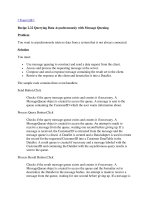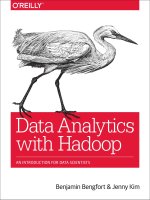Fast data analytics with spark
Bạn đang xem bản rút gọn của tài liệu. Xem và tải ngay bản đầy đủ của tài liệu tại đây (11.2 MB, 75 trang )
Fast Data Analytics with Spark
and Python (PySpark)
District Data Labs
Plan of Study
-
Installing Spark
What is Spark?
The PySpark interpreter
Resilient Distributed Datasets
Writing a Spark Application
Beyond RDDs
The Spark libraries
Running Spark on EC2
Installing Spark
1.
2.
3.
4.
Install Java JDK 7 or 8
Set JAVA_HOME environment variable
Install Python 2.7
Download Spark
Done!
Note: to build you need Maven
Also you might want Scala 2.11
Managing Services
Often you’ll be developing and have Hive,
Titan, HBase, etc. on your local machine. Keep
them in one place as follows:
[srv]
|--- spark-1.2.0
|--- spark → [srv]/spark-1.2.0
|--- titan
...
export SPARK_HOME=/srv/spark
export PATH=$SPARK_HOME/bin:$PATH
Is that too easy? No daemons to
configure no web hosts?
What is Spark?
Hadoop 2 and YARN
YARN is the resource management and computation framework that is new as
of Hadoop 2, which was released late in 2013.
Hadoop 2 and YARN
YARN supports multiple processing models in addition to MapReduce. All
share common resource management service.
YARN Daemons
Resource Manager (RM) - serves as the central agent for managing and
allocating cluster resources. Node Manager (NM) - per node agent that
manages and enforces node resources. Application Master (AM) - per
application manager that manages lifecycle and task scheduling
Spark on a Cluster
-
Amazon EC2 (prepared deployment)
Standalone Mode (private cluster)
Apache Mesos
Hadoop YARN
Spark is a fast and general-purpose cluster
computing framework (like MapReduce) that
has been implemented to run on a resource
managed cluster of servers
Motivation for Spark
MapReduce has been around as the major framework for distributed
computing for 10 years - this is pretty old in technology time! Well
known limitations include:
1.
2.
Programmability
a. Requires multiple chained MR steps
b. Specialized systems for applications
Performance
a. Writes to disk between each computational step
b. Expensive for apps to "reuse" data
i. Iterative algorithms
ii. Interactive analysis
Most machine learning algorithms are iterative …
Motivation for Spark
Computation frameworks are becoming
specialized to solve problems with MapReduce
All of these systems present “data flow” models, which can
be represented as a directed acyclical graph.
The State of Spark and Where We’re Going Next
Matei Zaharia (Spark Summit 2013, San Francisco)
Generalizing Computation
Programming Spark applications takes lessons from other higher order
data flow languages learned from Hadoop. Distributed computations
are defined in code on a driver machine, then lazily evaluated and
executed across the cluster. APIs include:
- Java
- Scala
- Python
Under the hood, Spark (written in Scala) is an optimized
engine that supports general execution graphs over an RDD.
Note, however - that Spark doesn’t deal with distributed
storage, it still relies on HDFS, S3, HBase, etc.
PySpark Practicum
(more show, less tell)
Word Frequency
count how often a word appears in a document
or collection of documents (corpus).
Is the “canary” of Big Data/Distributed computing because a distributed
computing framework that can run WordCount efficiently in parallel at
scale can likely handle much larger and more interesting compute
problems - Paco Nathan
This simple program provides a good test case for parallel processing:
• requires a minimal amount of code
• demonstrates use of both symbolic and numeric values
• isn’t many steps away from search indexing/statistics
Word Frequency
def map(key, value):
for word in value.split():
emit(word, 1)
The fast cat
wears no hat.
The cat in the
hat ran fast.
def reduce(key, values):
count = 0
for val in values:
count += val
emit(key, count)
# emit is a function that performs distributed I/O
Each document is passed to a mapper, which does the
tokenization. The output of the mapper is reduced by
key (word) and then counted.
What is the data flow for word count?
cat
fast
hat
in
no
ran
...
2
2
2
1
1
1
Word Frequency
from operator import add
def tokenize(text):
return text.split()
text = sc.textFile("tolstoy.txt")
# Create RDD
# Transform
wc
= text.flatMap(tokenize)
wc
= wc.map(lambda x: (x,1)).reduceByKey(add)
wc.saveAsTextFile("counts")
# Action
Resilient Distributed Datasets
Science (and History)
Like MapReduce + GFS, Spark is based on two important papers
authored by Matei Zaharia and the Berkeley AMPLab.
M. Zaharia, M. Chowdhury, M. J. Franklin, S. Shenker, and I. Stoica, “Spark: cluster
computing with working sets,” in Proceedings of the 2nd USENIX conference on Hot
topics in cloud computing, 2010, pp. 10–10.
M. Zaharia, M. Chowdhury, T. Das, A. Dave, J. Ma, M. McCauley, M. J. Franklin, S.
Shenker, and I. Stoica, “Resilient distributed datasets: A fault-tolerant abstraction for inmemory cluster computing,” in Proceedings of the 9th USENIX conference on Networked
Systems Design and Implementation, 2012, pp. 2–2.
Matei is now the CTO and co-founder of Databricks, the
corporate sponsor of Spark (which is an Apache top level
open source project).
The Key Idea: RDDs
The principle behind Spark’s framework is the idea of RDDs - an
abstraction that represents a read-only collection of objects that are
partitioned across a set of machines. RDDs can be:
1.
2.
3.
4.
Rebuilt from lineage (fault tolerance)
Accessed via MapReduce-like (functional) parallel operations
Cached in memory for immediate reuse
Written to distributed storage
These properties of RDDs all meet the Hadoop requirements
for a distributed computation framework.
Working with RDDs
Most people focus on the in-memory caching of RDDs,
which is great because it allows for:
-
batch analyses (like MapReduce)
interactive analyses (humans exploring Big Data)
iterative analyses (no expensive Disk I/O)
real time processing (just “append” to the collection)
However, RDDs also provide a more general
interaction with functional constructs at a higher
level of abstraction: not just MapReduce!
Spark Metrics
Programming Spark
Create a driver program (app.py) that does the following:
1. Define one or more RDDs either through accessing data stored on
disk (HDFS, Cassandra, HBase, Local Disk), parallelizing some
collection in memory, transforming an existing RDD or by caching
or saving.
2. Invoke operations on the RDD by passing closures (functions) to
each element of the RDD. Spark offers over 80 high level operators
beyond Map and Reduce.
3. Use the resulting RDDs with actions e.g. count, collect, save, etc.
Actions kick off the computing on the cluster, not before.
More details on this soon!
Spark Execution
- Spark applications are run as independent sets of processes
- Coordination is by a SparkContext in a driver program.
- The context connects to a cluster manager which allocates
computational resources.
- Spark then acquires executors on individual nodes on the cluster.
- Executors manage individual worker computations as well as
manage the storage and caching of data.
- Application code is sent from the driver to the executors which
specifies the context and the tasks to be run.
- Communication can occur between workers and from the driver to
the worker.
Spark Execution
Worker Node
Executor
Task
Worker Node
Driver
SparkContext
Task
Application
Manager (YARN)
Executor
Task
Task
Worker Node
Executor
Task
Task









